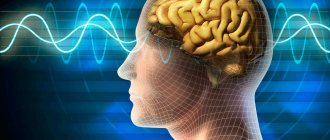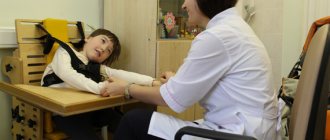Schizophrenia has many varieties. It is classified according to the rate of progression, characteristic symptoms, intensity of symptoms and other characteristics. In total, this pathology affects 0.5-1% of the population. One of its rare subtypes is hebephrenic schizophrenia. It is detected in 5% of patients with similar disorders. We will tell you what the features of hebephrenia are, how it arises, develops and is treated.
In this article
- History and main features
- Causes
- Symptoms
- Clinical cases
- Diagnostics
- Treatment
- Forecast
History and main features
The term “hebephrenic paraphrenia” was first used in 1871 by Ewald Hecker. In describing this disorder, he mentioned that it is “a special form of terminal dullness, the signs of which can be recognized in the early stages of the disease.” The pathology received its name in honor of the ancient Greek goddess of youth Hebe.
Today, the equivalent concepts of “hebephrenic schizophrenia”, “hebephrenic schizophrenia” and “hebephrenia” are used. You can also come across the term “schizophrenia of the disorganized type.” It is outdated, but in the literature you can still find the formulation “disorganized schizophrenia.”
The main feature of this disease is that the patient behaves like a child, even if he is an adult. In general, his behavior is inappropriate, foolish and mannered. Sometimes it is very ridiculous and obscene. The patient constantly giggles, smiles smugly, grimaces and plays pranks.
The onset of pathology usually occurs at 15-25 years of age. Residents of large cities often suffer from it. The incidence of development in women and men is approximately the same. The disease is not common. In its pure form, that is, without signs of other forms and types of schizophrenia, it is observed in only 5% of patients.
The schizophrenic defect in hebephrenia develops quickly, the pathology progresses rapidly, and is difficult to treat. There is a high probability that the patient will lose his purpose in life, and his existence will become meaningless.
Causes
Doctors name several reasons that could hypothetically lead to or provoke hebephrenia:
- genetic abnormalities;
- fetal hypoxia;
- intrauterine infections;
- epilepsy;
- childhood psychological trauma.
These are predisposing factors. It is clear that it is difficult to call them direct culprits, since their presence only increases the risk of developing the hebephrenic form of schizophrenia. The impetus for the appearance of the first signs may be:
- child abuse;
- unhealthy atmosphere in the family;
- constant stress;
- bullying at school;
- brain diseases of various etiologies;
- alcohol and drug use.
Medical practice shows that patients with hebephrenia in infancy have low weight, low intelligence and strong involuntary reactions to stimuli.
Also, children who are subsequently diagnosed with hebephrenic schizophrenia differ in:
- persistent antisocial characteristics;
- overly exemplary behavior;
- dependence on adults;
- increased sensitivity;
- lack of communication;
- reluctance to perform mental work;
- general lethargy and passivity.
In addition, patients with hebephrenia experience early sexual intercourse, problems with the law, and other antisocial behavior. They are prone to rebellion, disobedience, and drug and alcohol use. In other words, they behave deviantly.
Symptoms
The onset of the disease is difficult to distinguish from bad or ill-mannered behavior. The patient is fooling around, making faces and saying stupid things. But outsiders should be wary of the complete lack of logic in his words and actions. He also often complains of various illnesses, which indicates hypochondria. Sometimes a person can be aggressive. In general, his mood is excessively elevated, but is often replaced by apathy.
The main symptoms of hebephrenic schizophrenia:
- Disorganized thinking. The patient cannot formulate and logically justify his thoughts. Because of this, he jumps from one topic to another, without being able to stop at one thing. In some cases, his speech is so confused and incomprehensible that others perceive it as a set of sounds.
- Disorganized behavior. A patient with hebephrenia may constantly make some movements, as if he has nowhere to put his hands. He puts them behind his head, straightens his socks, scratches himself, knocks on the table with his fingers, etc. In severe cases, he is unable to perform ordinary everyday activities - wash, shave, get dressed. Some patients behave childishly and stupidly, but sometimes they behave aggressively.
- Sexual deviation. We are talking about displaying genitals and defecating in public places. Also, patients with hebephrenia love to joke obscenely, and at the level of an eighth-grader who giggles in biology lessons. In general, the sexual topic is of great interest to the patient, like any child during puberty.
- Inadequacy of emotions. The patient can be either overexcited or extremely apathetic. Sometimes his face shows no emotion at all, as if he feels nothing. But at the same time, at any moment he can laugh out loud, and in any place, for example, in a lesson or an important event.
- Misconceptions With hebephrenic schizophrenia, a person may be at the mercy of false beliefs that are formed as delusions. It seems to him that he is a great person or that someone is constantly chasing him.
- Self-isolation. Gradually the number of contacts with people is reduced. The patient interacts less and less with others, including loved ones. It is not only the lack of interest on the part of the patient that interferes, but also poor social skills.
- Unawareness. In this case, we are talking about the fact that the patient does not consider himself sick. At the same time, he can easily explain his condition or stay in the clinic: “my parents wanted it,” “the doctor advised me,” “the pills are making me a fool,” etc.
Most often, relatives of the patient turn to doctors, since the latter considers himself “normal.”
Delusions and hallucinations, which are typical signs of almost any schizophrenia, may be absent in hebephrenia.
In severe forms, catatonic and manic syndromes, delusions, hallucinations and severe hypochondria are observed. Symptoms such as depersonalization and derealization may be recorded, when the world around us seems unreal. Foolishness gives way to apathy, speech becomes more and more meager and primitive over time. Some patients become very interested in religion, philosophy, or a narrower topic, for example, the work of the subway.
Symptoms and course
According to ICD-10, for diagnosis, at least 1 of the following symptoms must be present:
- mental “echo” (the patient hears his thoughts), the belief in investing or taking away his thoughts with something from the outside, a feeling of openness of the thought process to other people;
- delusions of influence, mastery or passivity, distortion of perception;
- auditory hallucinations that comment on or discuss the patient’s behavior, other types of “voices”;
- delusional ideas that do not correspond to the culture in which the patient lives, absurd/impossible/grandiose beliefs.
Diagnosis also implies the presence of at least 2 of the following manifestations:
- daily vivid hallucinatory phenomena with delusions without an affective component;
- the presence of neologisms, sperrung (thought breaks), manifested in uncollected speech, its incoherence;
- symptoms of catatonia - hyperexcitation or stupor, negativism;
- symptoms not caused by other pathologies or medication use, which lead to social problems;
- apathy, speech impoverishment, inconsistency of emotions with current events;
- behavioral transformations - loss of interest, aimless activity, preoccupation with one’s own condition.
Patients' behavior is unpredictable, their reactions are unnatural. Problems with concentration, intelligence, and memory are typical. The mood is dynamic, aggressiveness is possible. Patients lack self-organization skills - they are not able to plan and implement their activities independently. There is a regression of instincts and a lack of focus. Emotional reactions look like grimacing, there is fragmentation and reasoning in thinking. Hallucinations and delusions are not an obligatory component, often occupying a secondary role.
The course of the disease is continuous, periodic (recurrent) or paroxysmal (fur-like). The most dangerous and difficult to treat is the continuous type. With this course, the pathology occurs without periodic intermissions. With the recurrent and fur coat-like variant, there are light intervals, during which the symptoms weaken or are eliminated altogether. With a continuous course, the symptoms are very acute, negative, and never fully go away without treatment.
Clinical cases
With hebephrenic schizophrenia, the patient does not feel shame, he has no sense of responsibility or caution. He may behave defiantly, ask tactless questions without expecting an answer, giggle and use foul language. Almost constantly, such patients laugh at their own jokes. Moreover, their laughter seems unnatural, childish, feigned.
A typical example is the development of hebephrenia in a 14-year-old teenager. Until this age, he was diligent and obedient, studied well, and was raised in a complete family without relatives with mental disorders. During puberty, behavior deteriorated.
The patient stopped attending school, wandered around the city, undressed and pestered passers-by, began to smoke and drink alcohol. He categorically refused hygiene procedures, was often rude, showed his genitals to others, and attempted to defecate in the middle of the room. He was forcibly hospitalized.
Another example is a 19-year-old boy. I was admitted to the clinic with the typical symptoms of hebephrenia described earlier. During conversations with the doctor, he constantly made faces and periodically inserted obscene jokes into his speech. In general, I reasoned relatively normally. He remembered the dates and talked enthusiastically about the metro system. When I tried to remember all the stations, I got confused. The doctor tried to change the conversation to another topic, but the patient showed signs of aggression.
The patient believed that the state paid him a very small disability benefit, and the pills made him “a fool.” During the conversation with the doctor, he always moved his hands and fidgeted in place. Demonstrated the behavior of a 10-year-old child. To the question “why is he in the clinic?” answered that he was “crazy.”
The third example is a 16-year-old teenager. He was raised by his mother, and a very suspicious woman. One of the relatives was treated in a psychiatric clinic. He developed normally until the age of 12. He showed success at school, was distinguished by curiosity, and had good characteristics.
However, the teenager suddenly became rude and disobedient. At the age of 14, I began to develop very quickly physically. Signs of sexual deviation appeared. He began to consider himself a freak, made faces in front of the mirror for a long time, and became addicted to gambling.
Over time, he became more and more undisciplined, hypochondria developed - he forbade his mother to touch food, as he was afraid of infection. He was hospitalized at the age of 16 from the street when he was walking around naked.
Diagnosis
ICD-10
This section is translated from the article Personality Disorder. (edit | history)
Diagnostic criteria from the version of the International Classification of Diseases, 10th revision ICD-10, adapted for use in Russia (general diagnostic criteria for personality disorders, which must be met in all subtypes of disorders)[5]:
Conditions that are not directly attributable to extensive brain damage or disease or other mental disorder and meet the following criteria:
- a) marked disharmony in personal attitudes and behavior, usually involving several areas of functioning, such as affectivity, excitability, impulse control, perceptual and mental processes, as well as style of relating to other people; in different cultural conditions it may be necessary to develop special criteria regarding social norms;
- b) the chronic nature of an abnormal style of behavior that arose a long time ago and is not limited to episodes of mental illness;
- c) the abnormal style of behavior is comprehensive and clearly disrupts adaptation to a wide range of personal and social situations;
- d) the above-mentioned manifestations always arise in childhood or adolescence and continue to exist into adulthood;
- e) the disorder causes significant personal distress, but this may only become apparent later in the course of time;
- f) usually, but not always, the disorder is accompanied by a significant deterioration in professional and social productivity.
— International Classification of Diseases (10th revision), adapted for use in the Russian Federation — /F60/ Specific personality disorders. Diagnostic criteria[5]
To classify a personality disorder into one of the subtypes defined in ICD-10 (for diagnosis of most subtypes), it is necessary that it meets at least three criteria defined for this type [5].
Diagnostic criteria from the official, international version of ICD-10 from the World Health Organization (general diagnostic criteria for personality disorders, which must be met in all subtypes of disorders)[6]:
- G1. An indication that an individual's characteristic and consistent patterns of internal experience and behavior as a whole deviate significantly from the culturally expected and accepted range (or "norm"). Such a deviation must manifest itself in more than one of the following areas: 1) cognitive sphere (that is, the nature of perception and interpretation of objects, people and events; the formation of attitudes and images of “” and “others”);
- 2) emotionality (range, intensity and adequacy of emotional reactions);
- 3) controlling drives and satisfying needs;
- 4) relationships with others and the manner of solving interpersonal situations.
- G2. The deviation must be complete in the sense that inflexibility, lack of adaptability, or other dysfunctional characteristics are found in a wide range of personal and social situations (that is, not limited to one “trigger” or situation).
- G3. The behavior noted in G2 indicates
personal distress or adverse effects on the social environment.- G4. There must be evidence that the deviation is stable and long-lasting, beginning in late childhood or adolescence.
- G5. The disorder cannot be explained as a manifestation or consequence of other mental disorders of adulthood, although episodic or chronic conditions from sections F0 to F7 of this classification may exist simultaneously with it or arise against its background.
- G6. Organic brain disease, trauma or brain dysfunction should be excluded as a possible cause of the deviation (if such an organic condition is identified, rubric 07 should be used).
Original text (English)
- G1. Evidence that the individual's characteristic and enduring patterns of inner experience and behavior deviate markedly as a whole from the culturally expected and accepted range (or 'norm'). Such deviation must be manifest in more than one of the following areas: (1) cognition (ie ways of perceiving and interpreting things, people and events; forming attitudes and images of self and others);
- (2) affectivity (range, intensity and appropriateness of emotional arousal and response);
- (3) control over impulses and need gratification;
- (4) relating to others and manner of handling interpersonal situations.
- G2. The deviation must manifest itself pervasively as behavior that is inflexible, maladaptive, or otherwise dysfunctional across a broad range of personal and social situations (ie not being limited to one specific 'triggering' stimulus or situation).
- G3. There is personal distress, or adverse impact on the social environment, or both, clearly attributable to the behavior referred to under G2.
- G4. There must be evidence that the deviation is stable and of long duration, having its onset in late childhood or adolescence.
- G5. The deviation cannot be explained as a manifestation or consequence of other adult mental disorders, although episodic or chronic conditions from sections F0 to F7 of this classification may co-exist, or be superimposed on it.
- G6. Organic brain disease, injury, or dysfunction must be excluded as possible cause of the deviation (if such organic causation is demonstrable, use category F07).
— International Classification of Diseases (10th revision) — /F60/ Specific personality disorders. Diagnostic criteria[6]
A personality disorder, usually characterized by a gross discrepancy between behavior and prevailing social norms, characterized by the following (diagnosed when the general diagnostic criteria for personality disorder meet three or more criteria):
- a) callous indifference to the feelings of others;
- b) a rude and persistent position of irresponsibility and disregard for social rules and responsibilities;
- c) inability to maintain relationships in the absence of difficulties in their formation;
- d) extremely low ability to withstand frustration, as well as a low threshold for the discharge of aggression, including violence;
- e) inability to feel guilty and benefit from life experiences, especially punishment;
- f) a pronounced tendency to blame others or put forward plausible explanations for one’s behavior, which leads the subject to conflict with society.
As an additional symptom, constant irritability may occur. In childhood and adolescence, conduct disorder may confirm the diagnosis, although it is not necessary.
Note: For this disorder, it is recommended to consider the balance of cultural norms and regional social conditions to determine the rules and responsibilities that are ignored by the patient. Since in the event of a one-time violation of established norms by society, all the people who were thus deceived no longer consider society decent in terms of further implementation of the remaining norms.
Included:
- sociopathic disorder;
- sociopathic personality;
- immoral personality;
- antisocial personality;
- antisocial disorder;
- antisocial personality;
- psychopathic personality disorder.
Excluded:
- behavioral disorders (F91.x);
- emotionally unstable personality disorder (F60.3-)[7].
DSM-IV and DSM-5
To diagnose antisocial personality disorder according to DSM-IV-TR and DSM-5, in addition to the general criteria for a personality disorder, the presence of three or more of the following points is necessary [4]:
- Inability to conform to social norms and respect laws, manifested in their systematic violation, leading to arrests.
- Hypocrisy, manifested in frequent lies, use of pseudonyms, or deception of others in order to gain profit.
- Impulsivity or inability to plan ahead.
- Irritability and aggressiveness, manifested in frequent fights or other physical confrontations.
- Taking risks without taking into account the safety of yourself and others.
- Consistent irresponsibility, manifested by repeated failure to maintain a particular work schedule or meet financial obligations.
- Lack of remorse, manifested by an indifferent attitude towards harming others, mistreating others, or stealing from other people.
By criterion B
This diagnosis is made only to adults.
Criterion C
- There must be evidence of the same symptoms present before the age of 15 years. Antisocial behavior should not only be observed during episodes of schizophrenia or mania[8].
Other
Theodore Millon proposed 5 subtypes of dissocial personality disorder.[9] However, they are not recognized in the DSM and ICD.
| Subtype | Traits |
| Nomadic psychopaths (includes schizoid and avoidant traits) | Vagabonds, adventurers, wanderers. They usually adapt quickly in difficult situations, are insightful and impulsive. |
| Evil psychopaths (includes sadistic and paranoid traits) | Warlike, evil, sadistic, cruel, foreseeing betrayal and wanting revenge, fearless. Many serial killers fit these criteria. |
| Greedy psychopaths (includes passive-aggressive traits) | Predatory, envious, seeks more profit, stingy and greedy. |
| Risk-taking psychopath (includes hysterical traits) | Fearless, adventurous, bold, daring, reckless, pursuing unsafe activities. |
| Reputation-protective psychopath (includes narcissistic traits) | Has a need to be indomitable and formidable. Irreconcilable when his status is questioned. Overreacts to adversity. |
Diagnostics
To accurately diagnose hebephrenic schizophrenia, you will have to observe the patient in a hospital for several weeks or months, depending on the condition for which the patient was hospitalized. As a rule, the question of hebephrenia arises when the foolishness does not go away within a month from the first day of observation. The following criteria are also used:
- there are no obvious delusions or hallucinations;
- there is a speech disorder;
- there are signs of mindless behavior.
It is important to carry out differential diagnosis. First, tumors of the frontal lobes of the brain, infectious inflammation, dementia due to Pick's disease (atrophy of brain structures) and Huntington's chorea (a disease of the nervous system) should be excluded. For this purpose, CT, MRI, EEG and fundus examination are prescribed.
If schizophrenia is suspected, the medical histories of relatives are always checked, since this pathology is often genetically determined.
Secondly, it is necessary to differentiate hebephrenic schizophrenia from hebephrenic syndrome, which can develop both within schizophrenia and as a separate disease against the background of epilepsy. The syndrome occurs with hallucinations, delusions and catatonia, and is also characterized by the following symptoms:
- contraction of facial muscles, grimacing;
- lack of motives in actions;
- causeless euphoria, elation.
The syndrome can lead to the development of schizophrenia or occur against its background, but this is not necessary. It all depends on how early treatment began.
Thirdly, it is necessary to distinguish hebephrenia from heboid psychopathy, which has similar symptoms, but occurs in a milder form.
Treatment with psychotropic drugs
Antipsychotic therapy is indicated in the presence of an acute condition. The choice of drug depends on the clinical symptoms of the attack (exacerbation). In case of dominance of psychomotor agitation, hostility, aggressiveness, antipsychotics are used, which have a predominant sedative effect (tizercin, chlorpromazine, chlorprothixene). If hallucinatory-paranoid symptoms predominate, “powerful” typical antipsychotics are prescribed that can fight them (haloperidol, trifluoperazine). The polymorphism of clinical symptoms requires the use of typical antipsychotics that have a broad antipsychotic effect (mazeptil or piportil). Sluggish schizophrenia is treated with low or medium doses of antipsychotics and antidepressants. In the case of sluggish schizophrenia, accompanied by phobias and obsessions, sedative tranquilizers (Relanium, phenazepam, alprazolam, lorazepam) are used.
Treatment
Therapy includes three areas: relief of symptoms, stabilization of the condition and prolongation of remission. To get rid of symptoms, the patient is prescribed antipsychotics and other drugs. In extreme cases, insulin comatose therapy is carried out, based on the artificial introduction of a person into a hypoglycemic coma.
Stabilizing treatment of hebephrenic schizophrenia is aimed at consolidating the result after relief therapy. For this purpose, antipsychotic drugs are prescribed in minimal dosages. If there is a catatonic syndrome, large doses of tranquilizers are administered intravenously.
The patient is in the hospital during treatment. Subsequently, he may be discharged, but he will have to take antipsychotics constantly. The patient status remains forever. The main task is to prolong remission. Individual work continues with the person. He sees a psychotherapist and sometimes goes to group sessions. Nursing care is important. Specially trained caregivers and nurses care for such patients.
At the same time, conversations are held with relatives, who need to be taught how to properly communicate with a schizophrenic. The problem is that any factor, even a minor one, can provoke a new attack, for example, a minor quarrel, conflict between spouses, divorce, etc.
In general, after successful therapy, the following effects can be achieved:
- prolongation of remission;
- increased performance;
- return of interests;
- reduction of aggression;
- improving quality of life.
If necessary, the doctor lowers or increases the dose of the drug.
Treatment of schizophrenia
The vast majority of people suffering from schizophrenia need qualified help in a psychiatric hospital. Hospitalization allows for constant monitoring of the patient, detecting minimal changes in his condition. At the same time, the clinical manifestations of the disease are detailed, additional studies are carried out, and psychological tests are performed.
Despite the achievements of modern medicine, methods that would completely cure schizophrenia are still unknown. However, the methods of therapy used today can significantly alleviate the patient’s condition, reduce the number of relapses of the disease and almost completely restore his social and daily functioning. a major role in the treatment of schizophrenia . For this purpose, three groups of psychotropic drugs are used: antipsychotics, antidepressants and tranquilizers. They are used for a long time (from a week to several years, up to lifelong use). It is important to remember that the earlier treatment for schizophrenia is started, the better the prognosis awaits the patient.
Forecast
The prognosis for hebephrenic schizophrenia is disappointing. The chances of a positive outcome are minimal. In addition, this pathology develops rapidly. Treatment usually begins when the patient is at the stage of severe exacerbation.
The patient should be shown to a specialist much earlier - when the first changes in behavior appear, especially in cases where there is a serious contrast. So, if a teenager was always obedient and studied well, but suddenly began to be rude to everyone and neglect his studies, it is recommended to at least consult a psychologist.
However, even when treated at an early stage of the disease, the effect is often temporary. It becomes increasingly difficult for the patient to control outbursts of anger. He gradually withdraws into himself and loses touch with the outside world. 2-3 years after the onset of the disease, an irreversible defect in emotional and volitional qualities occurs. It is necessary to isolate a person from society forever, since he poses a danger to himself and others.
In fact, the only thing that can be done is to maintain the remission phase for as long as possible. But in most cases, relapse cannot be avoided, since the pathology leads to serious destruction of the brain. In this case, the second exacerbation will be more severe than the first.
Help for hebephrenic schizophrenia
First aid is an examination by a doctor and establishment of an accurate diagnosis. The specificity of hebephrenic schizophrenia, like other schizophrenic diseases, determines the lack of a critical attitude towards one’s condition.
Patients often do not understand that “I am sick.” In addition, sometimes even they resist attempts by relatives to bring them to a psychiatrist for examination.
If you are faced with an acute manifestation of the disease - the sick person is agitated, does not respond to you, screams, makes ridiculous faces and shows aggression - you should immediately call an ambulance or an intervention team.
As a rule, in case of severe behavioral disturbances and potential danger to oneself or others, hospitalization is used; if the patient refuses, involuntary hospitalization is used.
If there is no overexcitation, but the patient stubbornly refuses to be examined by a doctor, visit a psychiatrist yourself (without the patient). At the consultation, the doctor, in your words, will assess the situation and tell you what to do correctly to start treatment.
Complications
The consequences of hebephrenic schizophrenia can be of two types. The first is the collapse of personality and withdrawal into oneself. A person's life loses any meaning. This option is described above.
The second group of complications is associated with the period of development of pathology before hospitalization. Due to hypersexuality, irresponsibility and aggressiveness of the patient, as well as due to the lack of a sense of shame, the following scenarios are possible:
- violation of the law (theft, sexual violence, etc.);
- alcohol abuse and drug use;
- dismissal from work, expulsion from the institute;
- promiscuous sexual intercourse;
- suicide attempts.
Convincing a patient to see a psychotherapist is quite difficult. Experts advise involving people who are an authority for the child. Perhaps he will listen to them. If there are none, call a doctor at home. Experienced doctors know how to persuade such patients to undergo examination. Otherwise, a person is forcibly hospitalized after committing a crime or attempting suicide.
Notes
- Millon, Theodore (2002). Psychopathy: Antisocial, Criminal, and Violent Behavior. Guidford Press. pp. 3–18. ISBN 1-57230-864-8. Retrieved 2008-01-13.
- Disease ontology database (English) - 2021.
- Monarch Disease Ontology release 2018-06-29sonu - 2018-06-29 - 2018.
- ↑ 1 2 American Psychiatric Association.
Diagnostic and Statistical Manual of Mental Disorders, Fifth Edition (DSM-5). - Arlington, VA: American Psychiatric Publishing, 2013. - P. 659-663. — 992 p. — ISBN 978-0-89042-554-1. — ISBN 978-0-89042-555-8. — ISBN 0-89042-554-X. - ↑ 1 2 3 World Health Organization.
F6 Personality and behavior disorders in adulthood [F60—F69] // International Classification of Diseases (10th revision). Class V: Mental and behavioral disorders (F00-F99) (adapted for use in the Russian Federation). - Rostov-on-Don: Phoenix, 1999. - P. 245-246. — ISBN 5-86727-005-8. - ↑ 1 2 World Health Organization.
The ICD-10 Classification of Mental and Behavioral Disorders. Diagnostic criteria for research. — Jeneva. — P. 149-150. — 263 p. (English) - ICD-10, “F60.2x Dissocial personality disorder.”
- Diagnostic and Statistical Manual of Mental Disorders: DSM-IV. — 4th edition. - Washington: American Psychiatric Publishing, May 1994. - 620 p. — ISBN 0-89042-061-0, ISBN 978-0890420614.
- Millon T.
Personality Disorders in Modern Life. - 2000. - P. 158-161. — ISBN 978-0-471-23734-1. - Gannushkin P.B.
Clinic of psychopathy, their statics, dynamics, systematics. - Nizhny Novgorod: Publishing House of the Nizhny Novgorod State Medical Academy, 1998. - 124 p. — 5000 copies. — ISBN 5-86093-015-1. - Robert D. Hare (English)Russian.
Devoid of conscience. The frightening world of psychopaths = Without Conscience. The disturbing world of the psychopaths among us / translation by B. L. Glushak. - Williams, 2007. - 288 p. — 5000 copies. — ISBN 978-5-8459-1103-2. - ↑ 12
Nancy McWilliams, “Psychoanalytic Diagnostics: Understanding Personality Structure in the Clinical Process,” chapter “Psychopathic (Antisocial) Personalities,” ed. "Class", 1998. - Internet Mental Health – antisocial personality disorder (undefined)
.
mentalhealth.com
. - ↑ 1 2 Hare RD.
Diagnosis of antisocial personality disorder in two prison populations // The American Journal of Psychiatry. — 1983. - Fazel S, Danesh J.
Serious mental disorder in 23,000 prisoners: a systematic review of 62 surveys (English) // The Lancet. - Elsevier, 2002. - February. - doi:10.1016/S0140-6736(02)07740-1.










